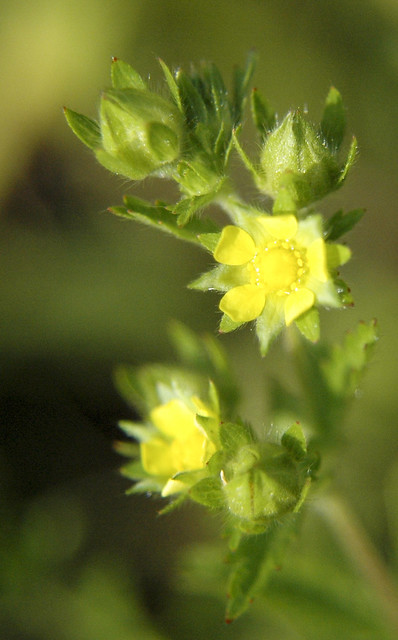rough cinquefoil
(Potentilla norvegica)
Conservation • Wetland • Description • Habitat • Ecology • Use • Distribution • Taxonomy
Description |
||
Rough cinquefoil is a 1′ to 3′ tall, erect, annual to short-lived perennial forb that rises on multiple stems from a shallow, branching taproot. In the spring basal leaves form a rosette close to the ground. The stems are erect or spreading, stout, branching, leafy, and covered with coarse, stiff hairs. They are green when young, becoming dark red in strong sun. Basal leaves are on long, hairy stalks. The are divided into 3 leaflets. The leaflets are hairy, elliptic to egg-shaped, up to 2″ long and 1″ wide. The margins have coarse, rounded teeth around the entire margin, including near the base. The terminal leaflet is on a distinct stalk up to ¼″ long. Stem leaves are similar to basal leaves, but are smaller and have shorter leaf stalks. They become smaller as they ascend the stem. The inflorescence is terminal clusters at the end of branches and individual flowers on short, hairy stalks arising from some of the leaf axils. The flowers are ⅓″ to ½″ wide. The 5 petals are yellow, rounded at the base, flattened at the broad tip, with a shallow notch at the tip.The 5 green sepals are longer than the petals and alternate with the petals. The 5 bractlets are dark green and about as long as the sepals when the flower is fully open. They alternate with the sepals and are visible below the petals when the flower is viewed from above. There are 10 to 20 yellow stamens. There is no floral scent. |
||
Height |
||
1′ to 3′ |
||
Flower Color |
||
Yellow |
||
Similar Species |
||
In the spring the plant forms a rosette close to the ground, which may be confused with common strawberry (Fragaria virginiana) or woodland strawberry (Fragaria vesca var. americana). However, the leaves of rough cinquefoil tend to be toothed around the entire margin, while the leaves of the strawberries tend to be untoothed near the base. Both of the strawberries are low and prostrate on the ground when mature, and have white flowers. Silvery cinquefoil (Potentilla argentea var. argentea) has larger flowers. The leaves are distinctly lobed and are white and woolly underneath. Sulphur cinquefoil (Potentilla recta) branches only above where the flower stems begin to appear. The flowers are pale yellow and larger. The flower petals are longer than the sepals between them. |
||
Habitat |
||
Dry. Fields, meadows, pastures, roadsides. Full or partial sun. |
||
Ecology |
||
Flowering |
||
June to August |
||
Pests and Diseases |
||
|
||
Use |
||
|
||
Distribution |
||||
|
Sources |
|||
| 6/4/2023 | ||||
Nativity |
||||
Native |
||||
Occurrence |
||||
|
||||
Taxonomy |
|||
| Kingdom | Plantae (Plants) | ||
| Division | Tracheophyta (Vascular Plants) | ||
| Subdivision | Spermatophytina (Seed Plants) | ||
| Class | Magnoliopsida (Dicots) | ||
Order |
Rosales (Roses, Elms, Figs, and Allies) | ||
Family |
Rosaceae (Rose) | ||
| Subfamily | Rosoideae (Brambles, Roses, Strawberries, and Allies) | ||
| Tribe | Potentilleae (strawberries, cinquefoils, and allies) | ||
| Subtribe | Potentillinae (cinquefoil) | ||
Genus |
Potentilla (cinquefoils) | ||
Subordinate Taxa |
|||
|
|||
Synonyms |
|||
Potentilla monspeliensis Potentilla norvegica ssp. hirsuta Potentilla norvegica var. hirsuta Potentilla norvegica var. labradorica Potentilla norvegica ssp. monspeliensis |
|||
Common Names |
|||
Norway cinquefoil Norwegian cinquefoil rough cinquefoil strawberry-weed tall five-finger upright cinquefoil yellow cinquefoil |
|||
Glossary
Axil
The upper angle where the leaf stalk meets the stem.
Bract
Modified leaf at the base of a flower stalk, flower cluster, or inflorescence.
Bractlet
A small, often secondary bract within an inflorescence; a bract that is borne on a petiole instead of subtending it.
Sepal
An outer floral leaf, usually green but sometimes colored, at the base of a flower.
Visitor Photos |
|||||
Share your photo of this plant. |
|||||
| This button not working for you? Simply email us at info@MinnesotaSeasons.com. Attach one or more photos and, if you like, a caption. |
|||||
|
|||||
MinnesotaSeasons.com Photos |
|||||
Plant |
|||||
 |
|||||
Inflorescence |
|||||
 |
 |
||||
Flower |
|||||
 |
|||||
Leaves |
|||||
 |
|||||
Stem |
|||||
 |
|||||

Visitor Videos |
|||
Share your video of this plant. |
|||
| This button not working for you? Simply email us at info@MinnesotaSeasons.com. Attach a video, a YouTube link, or a cloud storage link. |
|||
Other Videos |
|||

Visitor Sightings |
|||||
Report a sighting of this plant. |
|||||
| This button not working for you? Simply email us at info@MinnesotaSeasons.com. Be sure to include a location. |
|||||
|
|||||
MinnesotaSeasons.com Sightings |
|||||
Badoura Jack Pine Woodland SNA Bertram Chain of Lakes Regional Park Charles A. Lindbergh State Park Felton Prairie SNA, Bicentennial Unit Lake Alexander Woods SNA, South Unit Minnesota Valley NWR, Chaska Unit Minnesota Valley NWR, Rapids Lake Unit Northern Tallgrass Prairie NWR, Hoffman Unit Northern Tallgrass Prairie NWR, Rengstorf Unit Northern Tallgrass Prairie NWR, Touch the Sky Prairie Unit Pembina Trail Preserve SNA, Crookston Prairie Unit Prairie Creek WMA, Koester Prairie Unit Sand Prairie Wildlife Management and Environmental Education Area |
|||||

|
Created: Last Updated: © MinnesotaSeasons.com. All rights reserved. |


